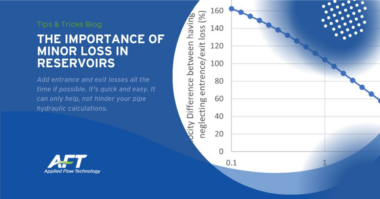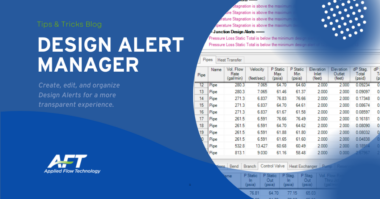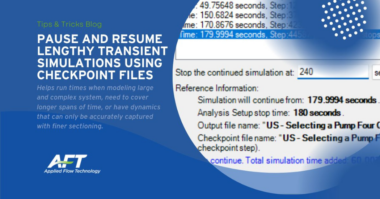Every design project needs to be completed on-time and on-budget. Most importantly, the engineering design must be properly sized to account for worst case scenarios.
With AFT’s Automated Network Sizing (ANS) Module, engineers are enabled to find the best design that will not only meet design requirements, but also help to eliminate the diminishing returns of current hand-sizing techniques by letting a computer do the tedious work for you.
Simply put, the ANS add-on module uses an existing AFT Fathom™ or AFT Arrow™ steady-state flow model to intelligently size liquid or gas systems through numerical methods.
Here are five ways automated network sizing helps engineers in the design process:
1. Reduce Oversizing
A common design shortcoming is to use excessive design factors during the sizing process to ensure a system accounts for any possible oversights. Using automated sizing software, engineers can reduce the high costs introduced by excessive design factors while ensuring their design requirements will be met in all possible operating conditions. A system’s design requirements can be adapted rather than applying a design factor to each component of a system, thus enabling the system to be sized accordingly, automatically, for a plethora of operating conditions.
2. Quickly Test Alternative Designs
“If this pipe was smaller, how would it impact operation and the bottom line? What if it were larger?”… These are common questions in the design phase too minute to waste precious engineering time answering. As the complexity of a system increases, the number of these questions increases while the return of answering each one diminishes.
Instead of leaving savings on the table due to diminishing returns, the ANS module can intelligently test thousands of alternatives for both gas and liquid systems as it perturbs pipe sizes and determines the next logical deviation. Among these deviations, the solver determines the absolute minimums while maintaining user-specified design requirements such as flowrates or pressure. Let the ANS module handle the iterations, enabling engineers to test more significant design changes in the same amount of time.
3. Size Pumps & Pipes Holistically
While other tools, such as sensitivity analysis, enable engineers to compare design alternatives; the potential for comparisons is limited. These analyses rarely consider interaction between variables on the macro scale since the resulting number of runs is exponentially proportional to concurrently tested variables. The use of sensitivity on pipe sizes in a network could take days, if not years to find a minimum.
The ANS module sizes the network holistically. By applying numerical methods, the software avoids the innumerable possibilities associated with multi-variable sensitivity. Instead, the slope of the system cost curve informs the next perturbation, reducing the necessary number of iterations to test while still reducing your system costs.
4. Size to Meet Multiple Operating Conditions
Rarely will a pipe network operate in one steady state condition without issue, whether it be changing demands, equipment maintenance, or variable supply conditions. With the ANS module, one established system can be sized to meet multiple operating conditions, each with their own set of design requirements. These different operating cases are represented as Dependent Design Cases (DDCs) and can account for different process requirements, bringing pumps online, varying a valve closure, or even accounting for the anticipated flow requirement of a planned future expansion.
5. Size to Win a Bid or Meet a Budget
The ANS module includes the capability to consider the time value of money by incorporating variable recurring costs over the life of the system. By time-discounting recurring expenses such as energy usage and maintenance, designs sized to minimize initial or life-cycle costs can be compared on the same terms over the same lifespan. Alternatively, an engineer can reap the energy saving benefits of life-cycle cost minimization for an initial investment limit, reflecting real-world budgetary restrictions. The ANS module allows you quickly to test all of these options to justify design choices to a client or to a manager.
Learn more about AFT’s Automated Network Sizing (ANS) Module and how it can help your firm avoid deadline driven compromise, reduce system costs, and inform the design process, automatically.




Comments